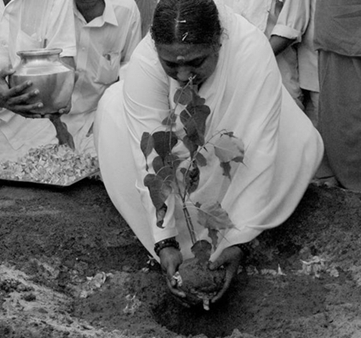
| Home | Source Reduction | Friends of Green Friends | Newsletters |
| Gardening | Resources | What You Can Do | Embracing The Trees |
| India’s Enduring Love for Trees |
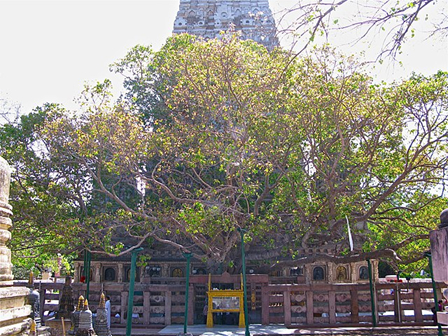 The Bodhi Tree at Bodh Gaya - By Ken Wieland from Philadelphia, USA - The Bodhi Tree - Bodh Gaya, CC BY-SA 2.0 |
|
In India, trees have been regarded with deep respect and reverence throughout the ages. It is said that the Buddha, who lived in India more than 2,500 years ago, advised his followers to plant five trees a year, and to maintain them. Mohandas Gandhi, in his old age, preferred to eat only food from trees, as well as a little goat milk. Sri Mata Amritanandamayi, or Amma, has told us that in ancient times in India, people would perform a puja to worship trees. If there was a need to cut a tree down, or even before plucking its fruit or leaves, they would seek its permission and apologize. "In the old days, there was no specific need for environmental preservation," Amma says, "because protecting Nature was part of worshiping God and life itself." "If people did need to kill a tree in those days, they would plant not just one, but several more to replace it." "More than remembering 'God', the people used to love and serve Nature and society." "They saw the Creator through the creation. They loved, worshipped and protected Nature as the visible form of God." |
The Original Tree Huggers |
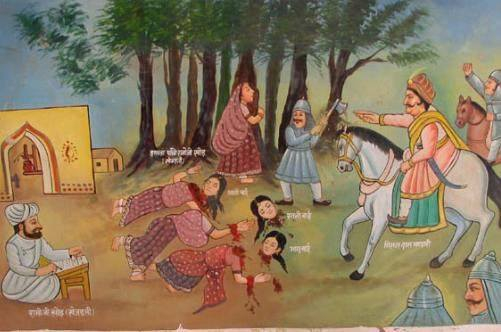 An artist's depiction of the Bishnois massacre |
|
At least one community in India has lived by similar values for the past few hundred years. The people are of the Bishnoi faith, which is described as an offshoot of Hinduism. Their faith requires non-violence and compassion to all living things. Their religion prohibits cutting down green trees, so only dead trees are used for firewood, and before burning it the Bishnois carefully remove any insects. Even at times when the people have lacked sufficient food or water, they would not allow birds and animals to go hungry or thirsty. Although the community is located in the harsh climate of Rajasthan’s Thar Desert, the Bishnois created a beautiful forest and lush vegetation through their long-time love, service and harmonious cooperation with Nature. However, nearly 300 years ago in 1730, their faith was severely tested. |
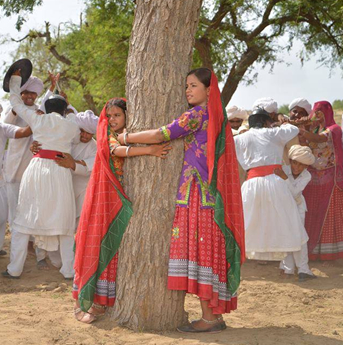 A re-enactment of Amrita Devi's sacrifice |
|
The king of Jodhpur planned to build a new palace, and sent his men to cut down green khejri, or acacia trees. In Rajasthan, khejri trees are held as sacred, much as banyan and peepul trees are in other regions of India. The men of the village were away, working in the fields when the king’s men arrived. On hearing the sound of their axes, a villager named Amrita Devi begged the men to stop. They refused -- they had orders from the king. Amrita Devi embraced one of the sacred trees. Although she was warned that her life was on the line, she reportedly replied that if a tree could be saved at the cost of her head, that was acceptable. Amrita Devi’s three young daughters saw their mother sacrifice her life for the trees, and calmly chose the same fate. As word spread, the village council met and unanimously chose to continue this incredible sacrifice to protect the trees. So did Bishnois from other nearby villages. Over several days, 360 more villagers died, beheaded by the king’s men as they embraced their beloved and sacred trees. When the king heard about this massacre, he ordered the loggers to stop. He apologized to the villagers and signed legislation to protect the area, including the trees and wildlife within it. We don’t know how many trees might have been saved by the villagers’ actions during those terrible days, but many positive things grew out of it. Their selfless actions were honored with the planting of 363 khejri trees (to match thhe 363 villagers who died) and the installation of a cenotaph at the site. The Indian government has also commemorated the martyrs’ sacrifice with an Amrita Devi Bishnoi Wildlife Protection Award, given to recognize exemplary work in wildlife protection, or for great courage and valor to protect wildlife. |
The Chipko Movement - Landless People Demand Protection of Nature |
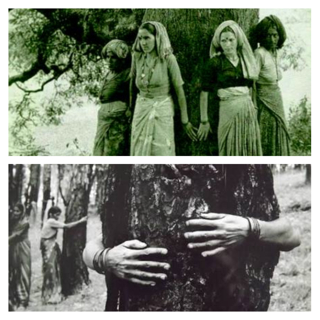 By Nehal Jain 1998 (Own work) [CC BY-SA 4.0 (https://creativecommons.org/licenses/by-sa/4.0)], via Wikimedia Commons |
|
The story of the Bishnoi’s non-violent protest later became the inspiration for the Chipko movement, or Chipko Aandolan, which began in 1973 in Uttrakhand (formerly Uttar Pradesh). In turn, the Chipko movement inspired non-violent protests against deforestation all over the world. This movement began in the Himalayan region of Uttrakhand, where foreign logging companies were winning contracts to clear-cut forested areas. The rural villagers noticed the harmful effects this had -- deforestation depleted their water resources, created an increase in soil erosion, and negatively affected their crops. There was also a growing awareness that clear-cuts increased flooding, such as the severe floods during the 1970 monsoon season, which cost the lives of more than 200 people in the region. A Gandhian social activist and environmentalist, Chandi Prasad Bhatt, had been working to help villagers create small industries that relied on local resources. In Mandal village, the plan was to build agricultural tools using a small amount of local wood, but in April, 1973, the government denied the villagers’ request to cut down ten ash trees for that purpose. Instead, they awarded a contract for 300 trees to a distant sporting goods manufacturer. |
|
When appealing the government decision didn’t work, Bhatt led the villagers into the forest. Like with the Bishnois many years before, they hugged the trees to prevent loggers from cutting them down. After some time, the government relented. The manufacturer’s contract was cancelled, and the villagers were awarded the ten trees they had requested. |
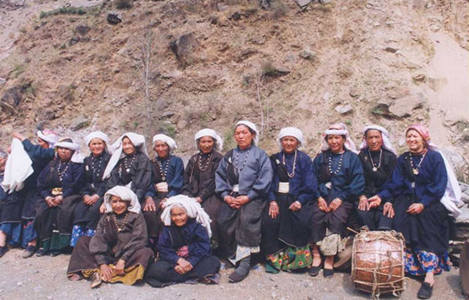 Participants of the first all-woman Chipko action at Reni village in 1974, reassembled thirty years later CC-BY-SA-2.5,2.0,1.0; Released under the GNU Free Documentation License |
|
In the following year, the government awarded a contract to cut down 2,000 trees near the village of Reni. Students organized a massive demonstration. One day, the men of the village were invited to a nearby city, with the understanding they would be offered government compensation. Instead, the loggers moved in to start work. Twenty-eight village women confronted the men, asking them to stop. When talking failed and they were threatened with guns, the women hugged the trees and kept a vigil all night. People from nearby villages joined them over the next days. Finally, after a four-day standoff, the loggers left. This was a bigger success -- this time, the state government agreed to study the effects of deforestation in the area, and then banned commercial logging for ten years. |
|
Over about eight years, more than 150 villages became involved in the Chipko movement. It gained the name from the Hindi word for ‘to stick’ or to hug. The villagers used various non-violent methods of protest, including tree-hugging, undertaking lengthy fasts, and tying sacred threads around the trees. From the beginning, village women were very active in the Chipko movement, with some even stepping forward to become leaders. After seeing the destruction left behind by big companies from outside the region, the Chipko movement demanded local control of forests, land and water. They also wanted small-scale economic development that would not destroy the ecological balance their lives depended upon. Eventually Indira Gandhi’s government banned logging for 15 years in the Himalayan areas to permit the regrowth of green cover. The Chipko activists turned their energies to growing trees in nurseries and to reforestation work, as well as bringing attention to other environmental problems such as those caused by mining. Other groups all over India, and even in other countries, were inspired to non-violently protest against deforestation, degradation of the environment, and misuse of natural resources in their local areas. |
The Importance of Forests |
|
|
| As Amma tells us, "Forests play the most important role in maintaining Nature’s harmony. It is only due to them that there is any semblance of harmony in the world today."
While scientists have known for years that trees absorb carbon dioxide (one of the gases causing global warming), only recently they found this is not the only -- or perhaps even the most important -- cooling effect that forests have. An international study published in Nature Climate Change says trees also regulate the exchange of energy between the earth’s surface and the atmosphere. Because of their height, trees powerfully effect heat transfer, by causing movement of surrounding air, and also by releasing moisture into the air. "Forests play a more important role in cooling the surface in almost all regions of the Earth than was previously thought." says study coauthor Kaiguang Zhao, assistant professor of environment modeling and spatial analysis at Ohio State University. "This really affirms the value of forest conservation and protection policies in the fight against climate change," he adds. Trees and forests also produce oxygen, clean and filter rainwater, and help retain water in the ground, as well as reduce levels of air pollution. |
|
As Amma reminds us, "We must stop polluting and exploiting Mother Nature. We have to protect her in order to ensure our survival as well as the survival of future generations." "Nature is our first mother. She nurtures us throughout our lives. Our birth mother may allow us to sit on her lap for a couple of years, but Mother Nature patiently bears our weight our entire life... " "Just as a child is obligated to his birth mother, we should all feel an obligation and responsibility toward Mother Nature." |
Reforesting an Island |
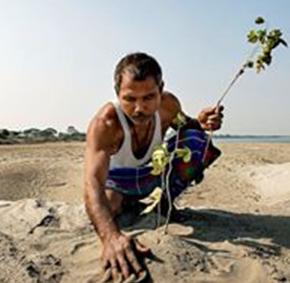 Jadav Payeng planting a tree |
|
One man who has spent most of his life acting from a deep sense of responsibility to Mother Nature was the subject of the popular short video, The Forest Man of India. As a teenager, Jadav "Molai" Payeng was disturbed when he noticed many snakes dying, and fewer migratory birds near his Mishing tribal village in Assam. Village elders in the nearby Deori community told him it was because floods had eroded the forest cover that had protected the wildlife. Paveng took the trouble to contact the forest department. Their response was a suggestion that he plant trees himself. And so he did. In fact, Payeng made daily visits to Majuli Island in the River Brahmaputra for 30 years. When he started, the island was a deserted, empty sandbar. Each day he planted a few saplings. On his first trip, he took 50 seeds and 25 bamboo plants, given to him by the Deoris. Over the years he collected different kinds of seeds from other indigenous groups. With his steady care and attention, slowly the sandbar began to support life. Locals started calling him “Molai”, which means 'forest'. “I knew I had to make the planet greener,” Payeng told thebetterindia.com. His efforts have had bountiful results. He has reforested a lush jungle of 1,360 acres (more than 1.5 times the size of New York’s Central Park). Now known as Molai Forest, it provides shelter for a host of wild animals: tigers, rhinos, monkeys, deer, rabbits, and many kinds of birds. During half the year it even receives visits from a group of more than 100 elephants. |
| There are several thousand trees of various kinds, including baheda, teak, gambhari, custard apple, star fruit, gulmohur, devil’s tree, tamarind, mulberry, mango, jackfruit, plum, peach and banyan. There is also elephant grass, medicinal plants, and more than 300 hectares of bamboo.
Payeng couldn’t carry all the water he needed to water his large, growing jungle, so he developed a method of building a bamboo platform over each sapling, on which sat an earthen pot with small holes in it. Water would drip down through the holes and water the saplings through the week. In 2015, Payeng was invited to speak at the United Nations Conference on Climate Change in Paris. Referring to the role trees play in fighting climate change - storing carbon, creating oxygen, and cleaning the air -- he asked the 20,000 attendees, "We meet for the sake of economy, but what are we doing for oxygen? Only trees can give you oxygen." The same year, Payeng was honored with India’s fourth-highest civilian award, "Padma Shri". Though he has received much recognition for his environmental work, Payeng still lives very simply in a hut in the forest with his wife and three children. They keep cows and buffalo, their income coming from sales of the animals’ milk. He is planning to start yet another forest on another sandbar island of the Brahmaputra, as well as to plant trees along two highways near the same river, in an area badly deforested by the 15-year construction of India’s longest road and railway bridge project. Many groups and individuals have honored Payeng for his contribution to India and the world, and his incredible demonstration of what one dedicated person can achieve, yet perhaps few of us truly appreciate its great value and importance. Payeng, like Amma, has a deep intuitive knowledge that forests and nature are essential to continued life on earth. "Jungle is my life," he said simply, in an interview with The Hindu newspaper. "It is your life too." |
Top
Present Day HeroesIn India today, there are many stresses on nature as there are in countries around the world, including resource development, encroaching cities, and high levels of pollution. Yet, there is a deep vein of love for nature in this country that seems to inspire more than a few individuals to spend years of their life planting trees and serving Nature. These heroes and heroines see the vital importance of trees and are protecting nature and planting trees in inspiring numbers. Many of these visionaries were born into poverty and had few resources throughout their lives, yet were moved by the call of dharma. Instead of focusing only on putting themselves ahead, they selflessly planted trees, which would benefit many other beings as well as Mother Nature herself. Many were ridiculed, criticized and laughed at for their efforts. One has even been sued for planting trees. Yet they all persevered, most spending much of their own money and sacrificing large amounts of their free time for years, even decades, in order to plant incredible numbers of trees. There isn’t enough space to include all of these inspiring people. In fact, there seem to be so many generous and passionate tree-planters in India that one may well wonder if this country has the highest concentration of them in the world! |
Helping Others Plant Trees with a 'Tree Bank’' |
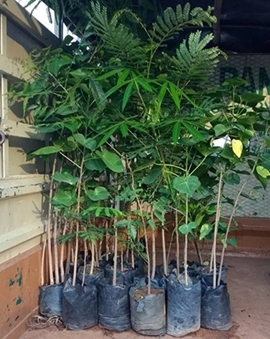 Saplings from Mullaivanam 's tree bank |
|
In Chennai, one of these heroes has established a tree bank, which gives free trees to those who ask, and will even help them plant it. G. Mullaivanam has also founded an impressive group of 355 volunteers, who reportedly plant a tree in each of Chennai’s 155 divisions each day. Mullaivanam started the tree bank out of his concern that Chennai’s green cover was only 6 per cent. He knew that planting trees would help reduce carbon dioxide pollution in the air, and would also provide a welcome cooling effect, due to the shade they create as well as evaporative cooling caused by the trees’ leaves. Volunteers map and research the city’s trees, so their seeds can be gathered at the right time. These seeds are started in volunteers’ homes, where they are cared for until the saplings are big enough to plant. The volunteers help to ensure those who receive the free trees know how to plant them and care for them properly. They even visit three times a year to provide any necessary care or pruning. In addition, the group plants and maintains trees in areas of the city they identify as having few trees. Mullaivanam has been collecting and nurturing saplings to give away since the age of 13. In 2008, he decided to go bigger, and started enrolling volunteers, including many college students and IT workers. His tree bank has planted more than 9 million trees, and given away more than 1,300,000 saplings. The group also teaches environment awareness in schools. "The idea is to involve the public and sensitize them to the fact that technology is increasing pollution, and lifestyle is creating destruction," he told The Hindu newspaper. Mullaivanam is a third-generation farmer, who lives on the income from his organic farm and his flower decoration service. In his spare time he has planted trees by roadsides and around hospitals, schools, and government institutions. Mullaivanam has received much recognition for his work, but is not slowing down. His latest project is to plant one crore (ten million) neem seeds across all of India. He has also petitioned the Chennai high court to require buyers of vehicles to plant two to four trees (depending on how many wheels the vehicle has). "And growing those trees should be their responsibility," he says, "as it is all of us who are equally responsible for polluting the environment." |
Reducing Crime and Sharing God |
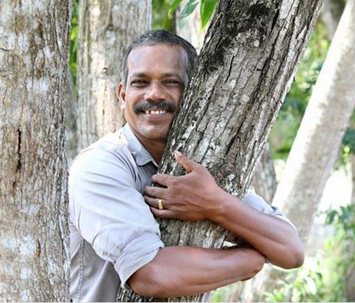
Source: Hindustan Times |
| For more than 40 years, V. Vidyadharan has been planting trees in Kerala’s Appaluzha and Ernakulum districts. Although he doesn’t allow this passion to interfere with his work as a police inspector, he carries saplings and shovels in his vehicle. He scouts out locations that might need more greenery, and plants trees in his off-hours along roadsides, walkways and train stations.
He even feels they may help reduce crime, pointing to studies done in the west that found well-treed areas can reduce residents’ blood pressure and have a soothing effect. He hasn’t kept count of how many trees he has planted over the years, but feels it must be more than one lakh (100,000) by now. He says he gets "indescribable pleasure" from seeing people waiting under the shade of one of the many trees he has planted. Although he calls himself an atheist, he also says that even under a creeper, people can experience God, and points out that the Buddha achieved enlightenment under a tree. "My life is cut out for a cause," he told the Hindustan Times last year. "I love to do it. I feel without trees there is no existence of mankind. They give us something to look up to.”" |
Educating Children to Respect Nature and Plant Trees |
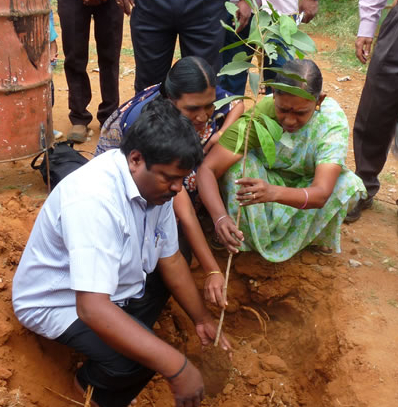 Marimuthu Yoganathan plants yet another tree |
|
Marimuthu Yoganathan is a bus conductor in Coimbatore, Tamil Nadu. He says he has planted more than three lakh trees in his lifetime, but he uses a different technique: presenting slide shows. When he’s not working he can often be found showing slide shows of his nature photos to school children. After the show, they head out to plant trees in the schoolyard. Each tree is named after the child that planted it. Yoganathan asks the children to look after the sapling like a brother or sister, and to water it daily. He keeps in touch with the children to find out how the trees are doing -- more than 20,000 now. He once took a month off work in order to help prisoners serving life sentences to start a tree nursery at Coimbatore jail. Yoganathan also educates young people about the environment, speaks out against cutting trees down, and leads drives to remove postering nails from trees in the city. “If a tree is being felled in the city and there is a round-faced man fighting to save it, then he is probably Yoganathan,” reported an article in The Hindu last year, saying the activist is also a familiar face in schools, colleges and villages around the city. Yoganathan fell in love with trees early, and planted his first tree in Class 8. As a young man working in the beautiful hills of Nilgiri District, he was appalled at the illegal tree-felling and smuggling, and protested against it, eventually deciding to spend his life helping the environment. He has received a state award, CNN-IBN’s Real Heroes Award, and the government of India’s Eco Warrior Award, among others. He regularly spends 40% of his income on buying saplings and educating school children. Over the past 30 years, he has visited more than 3,700 schools in 32 districts in Tamil Nadu. |
Planting Trees Through Partnerships |
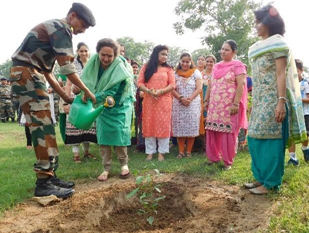 Radhika Anand's Mission FalVan project |
| More than 20 years ago, Radhika Anand of Delhi started her own organization, Plantology, to help start greening initiatives in India. Over the years, she has led many workshops on ecology and environmental conservation and awareness for youth, government workers and corporations. The daughter of a former Air Force officer was inspired to use quite a different method to plant more than 200,000 trees in just the past two years.
Concerned about air pollution and sustainability, Anand’s desire was to help create more oxygen and more food for all species, as well as to increase green cover. Although Anand was willing to help fund large-scale planting with her own savings, money earned through teaching workshops, and contributions from well-wishers, she was at first unsuccessful in finding a suitable partnership. She approached government agencies and forestry departments, but most lacked land or enough water to follow through. It took a chance encounter on a train to move Anand’s project forward. She happened to be seated next to a man whom she told about her ambitious project. The man was an army officer, and arranged for her to meet a general, whom he had told about the project and was interested in helping her achieve it. With the help of the Indian Army, Anand was finally able to mobilize tree-planting in a big way. Later, the Central Industrial Security Force (CISF) and the National Security Guard (NSG) also joined the planting effort. Many of the trees are planted in and around army formations to commemorate martyred Indian soldiers. The army has agreed to maintain the trees and the CISF and NSG have also planted trees in some residential areas. Anand’s project is called Mission: Falvan, which means 'fruit forest'. The project focuses on planting mainly fruit trees, and only those native to each region, as they require less water than exotic species and are more resilient. The project has planted fruit trees (including mango, blackberry, tamarind, amla, jamun, mulberry, guava, bel patra and jackfruit) across nine states -- Himachal Pradesh, Punjab, Haryana, Delhi, Uttar Pradesh, Rajasthan, Madhya Pradesh, Maharashtra and Goa. Mission Falvan’s goal is to plant at least 50,000 trees each year. The project is slated to begin planting trees in Bihar, Chhattisgarh, Andhra Pradesh and Tamil Nadu next. |
An Inspiring Row of Trees |
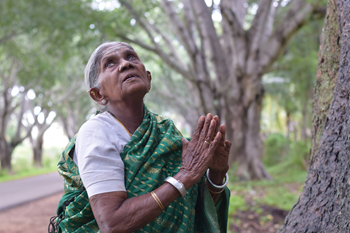 Thimmakka |
| Fifty years ago, Thimmakka and her husband began planting banyan trees in their village of Hulikal in Karnataka. Despite trying to have children for 25 years, they had not been able to conceive. Instead, they chose to plant trees.
he couple grafted saplings from banyan trees near their home, tended them in a little nursery, and then planted them on either side of the hot, dusty road to Kudur. After working as day laborers to earn their living, they would each carry two buckets of water up to 4 kilometers, refilling them from ponds or wells along the way, as often as four days a week to keep their saplings alive. They also built thorny fences to protect the young trees from cows or other animals. The trees, 384 of them, now line 5 kilometers of road with their majestic beauty, and provide cool shade for the local people who frequently need to travel to the next village. Thimmakka has been given the name Saalumarada, which means 'row of trees in Kannada. She is honored locally and internationally as an environmental hero. The British Broadcasting Company (BBC) in 2016 named Saalumarada Thimmakka as one of the world’s most influential and inspirational women. She has also received hundreds of awards for her environmental work. Although her husband Chikkayya passed away years ago, their work also brought an unexpected blessing. At the age of 14, a boy named Sri Umesh was so inspired by their example that he introduced himself to Saalumarada Thimmakka, and (with his parents’ blessing) later became her foster son. Umesh himself had been concerned about the environment since childhood. Umesh now looks after Saalumarada, is the president of her organization, runs a nursery, and distributes trees (now more than 500,000) to farmers. Like his foster mother before him, he too plants and looks after trees in many places, and has also given more than 500 lectures to raise environmental awareness. Last year, at the age of 105, Saalumarada Thimmakka told news station CNN: "I am very happy seeing my children. We have looked after the trees with love, and I am happy and proud." Umesh said, "I have a suggestion to everyone: We are born as human beings and will die as human beings, but to live we need to conserve nature. We cannot live without the environment." Thimmakka added, "Everyone from children to the elderly should plant and grow trees. It will be beneficial for all of us." Amma would agree with her. She has frequently spoken about the urgent need to re-establish harmony with Nature. "If we forget Nature," she has said, "we will cease to exist, for to do so is to walk toward death. If we forget this responsibility, it is equal to forgetting our own self. Let us try to reawaken this attitude. At present, the biggest threat to mankind is not a third world war, but the loss of Nature’s harmony and our widening separation from Nature." "We should be ready to change. Otherwise, we will be forced to change. If not change, then death—we have to choose one or the other. Amma has a request - each and every person on this planet should play their part in restoring harmony to Nature." |
Committed to Planting 5 Million Hectares of Forest |
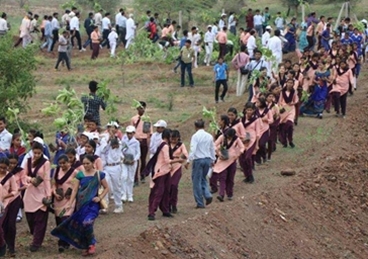 Guinness World Records is expected to confirm the achievement The Independent |
|
India is enthusiastically doing its part. Last year, in the state of Madhya Pradesh, an incredible 1.5 million volunteers of all ages, from children to elderly, helped plant more than 66 million trees in just one day. "By planting trees we are not only serving Madhya Pradesh but the world at large," Shivraj Singh Chouhan, the state’s chief minister, said in a tweet that day. More than 20 species of trees were planted along the Narmada river basin, and the huge effort broke the previous world record for tree-planting in one day. That record was also set in India - the previous year in Uttar Pradesh, when 50 million trees were planted in one day. Part of India’s commitment to the Paris Climate Agreement was to plant 5 million hectares of forest before 2030, in order to reforest 12 per cent of its land. This will increase forest cover to about 29 per cent of the country. In June 2017, after the U.S. pulled out of the Paris agreement, Prime Minister Narendra Modi reaffirmed India’s commitment, saying, "The protection of the environment and the mother planet is an article of faith." |
Embracing the World with TreesAfter the 2004 Indian Ocean Tsunami, Amma’s Embracing the World charitable organization helped plant 30,000 saplings on India’s coast to help stabilize 13 kilometres of coastline. Embracing the World has organized the planting of more than a million trees in the world since 2001, and is a member of the United Nations Billion Trees Campaign. Amma has said, “Each country should try to protect its remaining forest, and plant as many trees as possible. “Individually, we should each make a vow to plant at least one tree a month so that in a year, each person will plant 12 trees. If everyone participates, in just a short period we can restore Nature’s beauty to the face of the world.” In September, 2013, Embracing the World announced a new goal: to plant six million trees worldwide. Wherever you live in the world, you too can participate! We hope you have found some inspiration in these stories from India. |
| Home | Source Reduction | Friends of Green Friends | Newsletters | Resources | What You Can Do | Contact Us |
For more information, e-mail info@greenfriendsna.org |
||||||
